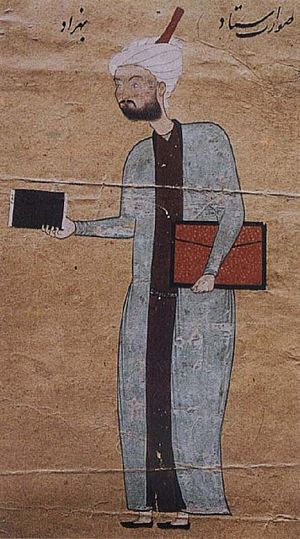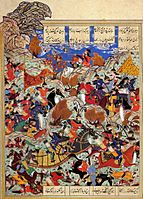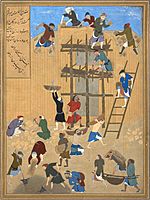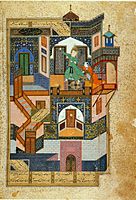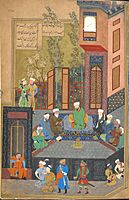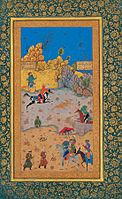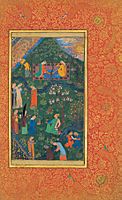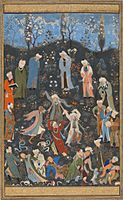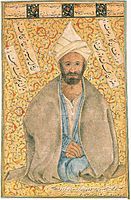Kamāl ud-Dīn Behzād facts for kids
Quick facts for kids
Kamāl ud-Dīn Behzād
|
|
|---|---|
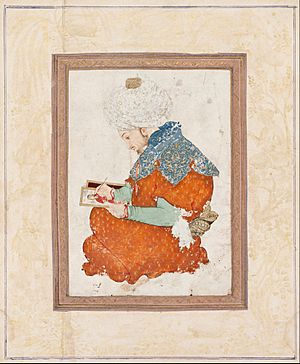 |
|
| Born | between 1455 to 1460 |
| Died | 1535 (aged 85) |
| Resting place | Tomb of Two Kamals |
| Occupation | Painter |
| Era | Medieval Period, Late Timurid, Early Safavid Iran |
|
Notable work
|
Painting photographs of Jami, Sultan Husayn Mirza Bayqara, Ali-Shir Nava'i, Ismail I |
Kamāl ud-Dīn Behzād (born around 1455-1460, died 1535) was a famous Persian miniature painter. He was also the head of royal art workshops in Herat and Tabriz. This was during the late Timurid dynasty and early Safavid periods in Persia.
Behzād is seen as one of the most important artists in Islamic miniature painting. He was a director of a workshop in Herat and worked in the Royal Library. His art was special because it mixed traditional Persian geometric styles with his own ideas. He often used large empty spaces, making the main subject of the painting stand out. His works show amazing skill with light and shadow, and each character looks unique. One of his most famous paintings is "The ... of Yusuf" from Sa'di's Bustan (1488). Many artists copied his style because he was so well-known and praised.
Biography
Behzād's full name was Ustād Kamāluddīn Be[i]hzād. We don't know his exact birth year, but it was between 1455 and 1460. He was born and lived most of his life in Herat. This city is in modern-day Afghanistan. It was a very important center for trade and culture in the Timurid Empire.
We don't know much about Behzād's childhood. But, it is said that he became an orphan when he was young. He was then raised by a famous painter and calligrapher named Mirak Naqqash. Mirak Naqqash was the director of the Timurid royal library.
Behzād was also supported by Ali-Shir Nava'i, a wise man, poet, and minister. This was during the rule of Timurid Sultan Husayn Bayqarah (1469–1506) in Herat.
Behzād's work can be seen in several old books from the 1480s. This shows he worked in the Sultan Hussein Bayqarah's library. In 1486, Sultan Hussein Bayqarah made Behzād the head of the royal workshops in Herat. He took over from Mirak Naqqash. Under Behzād's leadership, the art academy became very successful.
In 1506, Sultan Hussein Bayqarah died. Soon after, Herat was taken by the Bukhara Khanate. Some people think Behzād went to Bukhara between 1507 and 1510. Others say he stayed in Herat.
Behzād became even more famous during this time. There's a story that during a big battle in 1514, Shah Ismail I hid Behzād in a cave. He saw Behzād as a precious treasure.
In 1522, Shah Ismail I hired Behzād to work in Tabriz. This city was the capital of the new Safavid Empire. As the director of the royal workshop, Behzād greatly influenced Safavid painting. Shah Ismail I praised Behzād as "a miracle of our century."
Shah Ismail died suddenly in 1524. Behzād continued to work for Shah Ismail's son, Shah Tahmasp I (1524–1576). Behzād kept working in the Shah's workshop until he died in 1535.
Behzād's tomb is in Herat, on a hill called Kôh-i Mukhtâr.
Career and Style
Behzād is the most famous Persian miniature painter. But he was more like a director of a workshop. This workshop created beautiful illustrated books in a style he developed. In 1486, Behzād became the head of the Herat Academy. He had the support of Sultan Ḥusayn Bayqarah. He left this job in 1506. In 1522, Behzād moved to Tabriz. He followed Tahmasp, who was Shah Ismail I's son. In Tabriz, Behzād became the head of the Safavid royal library. He worked there until his death around 1536.
Persian paintings from that time often used geometric shapes, like buildings, to frame the people in the pictures. Behzād was also very good at painting natural scenes. When he used the traditional geometric style, he made it his own. He often used open, plain areas around which the action happened. He also guided the viewer's eye around the painting in a unique, flowing way. The way people and objects were shown was very natural and active. They were placed to keep your eyes moving through the whole picture.
He used light and dark colors more strongly and skillfully than other artists of his time. Another special thing about his work was his playful storytelling. For example, he might show just a hidden eye or part of a face. He also included surprising details, like a goat that looks like a demon.
Behzād's works stand out because of their unique characters and creative storytelling. These qualities matched the stories they were illustrating. Behzād also used symbolic colors to add meaning. He made Persian painting more realistic. This was especially true in how he showed people, giving them unique looks and natural movements.
It can be hard to know for sure which paintings Behzād himself painted. Many experts now say this isn't the most important thing. But most works believed to be by him are from 1488 to 1495.
One famous story he illustrated was about Yusuf (Joseph) and Zulaykha. This story was in Sadi’s Bustan much earlier. The poet Jami also wrote about it. Behzād's painting shows parts from both their writings. The painting uses architecture to divide space. This helps tell the story over time. For example, it shows Zulaykha leading Yusuf through different rooms. The most exciting part of the story is shown when Zulaykha tries to grab Yusuf, and he escapes. Behzād's choice to show many parts of the story at once made the painting very rich.
Legacy
One of Behzād's biggest impacts was how well he painted people and natural things. This made his paintings' stories and characters feel deeper. His human figures looked less stiff and moved more naturally. This gave his paintings more energy and emotion. Behzād also used geometric patterns and flattened scenes. This helped him show the whole story in one painting. It also made sure the viewer's eyes moved across the entire artwork.
Behzād was a master of painting and had a great artistic eye. He could create complex scenes that were still easy to understand. His paintings flowed well, showing his skill at making realistic scenes with only the most important parts. This doesn't mean his works were simple. Instead, everything he chose to include was painted perfectly. His works were full of emotion and showed his amazing control of the brush and colors.
Behzād was very famous during his lifetime. Rulers, like the Mughal emperors, paid a lot of money for his paintings. This added to his fame. Behzād became a key figure in the Herat school of painting. He became the head of the Herat academy in 1486 and left in 1506. As the head, he had a big influence on students. He shaped the styles and techniques of future Persian painters. Behzād's fame inspired other artists to copy his work or learn from his paintings. He also had a lot of power over how illustrated books were made.
Today, many experts are trying to make sure paintings are correctly given to Behzād. Some works that were thought to be his might not be. Some paintings have his signature and date, making them easier to confirm. But others were linked to him in the 1500s and only look like his style. This makes people wonder if they are real Behzād paintings or very skillful copies.
Behzād in literature
Behzād is mentioned in Orhan Pamuk's novel, My Name is Red. In the book, a group of Ottoman miniature artists sees him as one of the greatest Persian miniaturists.
Gallery
-
The construction of Khawarnaq castle (Arabic الخورنق) in al-Hira, c. 1494-1495 C.E.
-
A miniature painting by Bihzad illustrating the funeral of the elderly Attar of Nishapur after he was held captive and killed by a Mongol invader.
-
The hunting ground.
See also
 In Spanish: Kamāl ud-Dīn Behzād para niños
In Spanish: Kamāl ud-Dīn Behzād para niños
- Persian miniature
- List of Persian painters
- Behzād on the French Wikipedia
- Begzada


